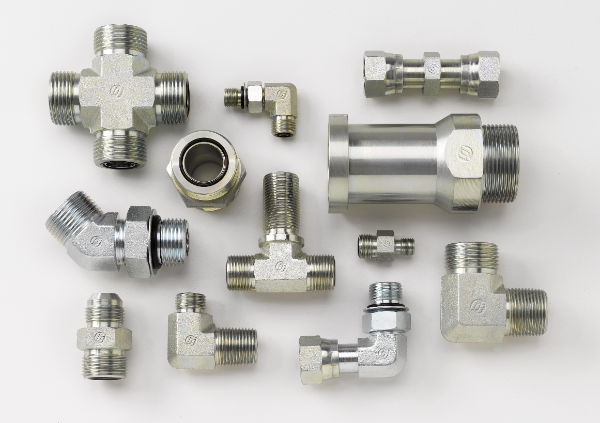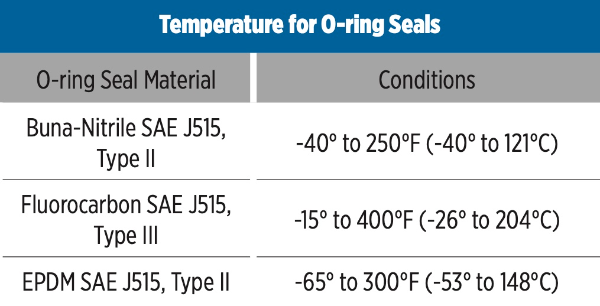We all know about using the STAMP (Size, Temperature, Application, Media, Pressure) method when choosing the right hydraulic hose fitting for your needs. We also know the goal is to have a leak-free connection that can handle the specific application. But what are the most popular fittings and why are they so common?
The most common hydraulic fitting styles are O-ring, Mated Angle, and Tapered Thread. Each of these three come in different variations for different applications.
O-ring Fittings
There are three types of O-ring fitting designs: O-ring Boss, O-ring Face Seal and O-ring flange. As one might imagine, each has an O-ring that creates the seal. 
O-ring Boss (ORB) Fittings: the O-ring seats between the threads and wrench flats and is situated around the OD of the male threaded end of the fitting. It seats against the female port to provide a very reliable leak-tight seal. O-ring boss fittings are either adjustable or non-adjustable.
Adjustable O-ring fittings are typically elbows or tees that are installed in a fixed direction and utilize a back-up washer which forces the O-ring into the cavity as the lock nut is tightened. They are considered adjustable because they are aligned toward a mating member before tightening.
Non-adjustable O-ring fittings are plugs and straight connectors that fit directly into a port without requiring alignment.
ORB fittings are highly preferred in many applications because they provide optimal sealing in medium to high pressure systems, as recommended by the National Fire Protection Association (NFPA).
O-ring face seal (ORFS) fittings have the O-ring situated in the face of the fitting to create a seal between two connected metal surfaces. When the connection is tightened, the O-ring compresses against a flat face of the mating fitting, tube or other mating female port. Though Nitrile 90 Durometer O-rings are most frequently used in ORFS fittings, there are many other compounds used depending on the application, such as a fluorocarbon or other material in very high temperature environments.
With design engineers increasing system pressures, which can result in added vibration, O-ring face seals are becoming even more popular due to their resistance to these high-vibration applications.
Material Selection Depends on System Temperature Ratings
Whether O-ring Boss or O-ring face seal, the operating temperatures for the fitting assemblies is dependent on the temperature ranges for the O-ring seal materials as shown in the table below.

Mated Angle Fittings
The two most popular mated angle (flare) hydraulic fittings are JIC 37-degree and SAE 45-degree. JIC 37-degree flare fittings are often used for high pressure applications in off-road and agricultural equipment, such as hydraulic loaders, excavators and tractors. Comparatively, SAE 45-degree flare fittings are more frequently seen in low to medium pressure applications, such as military and aerospace equipment. The flares and mating seats of these two fitting styles can only mate with a corresponding angle and are not interchangeable with each other.
Flare fittings have tapered ends that fit into a flared piece of tubing. They are seated in place with a threaded nut, providing a leak-tight and pressure-resistant seal. The tubing is flared with a flaring tool, such as a mandrel or rolling cone, yet pneumatic flaring tools are used for quick and accurate assembly.
Angled hydraulic flare fittings have either parallel or straight threads, yet the threads don’t actually form the seal. Instead, a seal is formed when the two mating flared angle seats (male and female) are joined together.
JIC fittings, also known as flare fittings, SAE 37-degree tube fittings and SAE J514 fittings are the most popular types of hydraulic fittings in America and are generally interchangeable with AN fittings. They are frequently used in hydraulic hose assemblies as the hose end adapter for the commonly used female JIC swivel fittings. In most cases, JIC fittings are rated for higher pressures in correlation with the specific tubing size-- often incorporating an elastomeric O-ring seal for a leak-proof connection. They are commonly manufactured in nickel alloys, brass, carbon & stainless steel. The most common JIC 37-degree flare fittings are made of carbon steel, with operating temperatures ranging from -65°F (-53°C) to +400°F (204°C).
SAE 45-degree fittings are machined with a 45-degree flare seating surface and are frequently used in automotive, refrigeration and air conditioning; as well as military and oil and gas industries for fuel equipment, plumbing, gasses and vacuum lines. They are not compatible with JIC connections due to the different flare angle. They are typically made of brass and designed for use with low pressure brass, copper, steel or aluminum tubing. SAE 45-degree flare fittings are easy to reassemble many times without affecting the seal, as long as they are not over-tightened. Overtightening can lead to distortion, cracking or cross threading due to brass’ soft material. They are ideal for low and high temperature applications, able to withstand intermittent temperature ranges of -65°F (-54°C) to 250°F (121°C). However, at wide temperature ranges, the maximum allowable pressure drops significantly.
NPT, BSPT and Metric Tapered Thread Fittings
Tapered threads achieve a metal-to-metal pressure-tight seal when assembled. Unlike O-ring and mated angle hydraulic fittings, tapered threads require the use of a thread sealant (such as Teflon tape) to create a pressure-tight seal. They are used to effectively seal pipes for fluid and gas transfer.Tapered threads make effective seals because the male and female threads compress and wedge together, providing a strong, leak-resistant connection. NPT pipe thread is the most common tapered pipe thread in the United States and Canada, though they are not compatible with British BSPT or Metric pipe threads. Metric threads are the most common style in Europe and have a precise inner and outer cylindrical diameter measured in millimeters.
The thread angle, otherwise known as an included angle, is 60 degrees for NPT and Metric threads, where BSPT threads have a 55-degree angle. Their thread shapes are also different, with NPT threads having flattened peaks and valleys, while BSPT threads are rounded.
The distinctive difference in metric threads is the V-shaped thread form, as well as male and female threads, both of which are parallel. Metric threads come in coarse and fine pitches. Coarse threads are more popular with a default pitch size, whereas fine threads have a smaller pitch size. To identify the difference, coarse threads are distinguished only by diameter, while fine threads are recognized by diameter as well as pitch size.
Sources Include:
Essentra PLC
Brennan Industries #1
Brennan Industries #2
